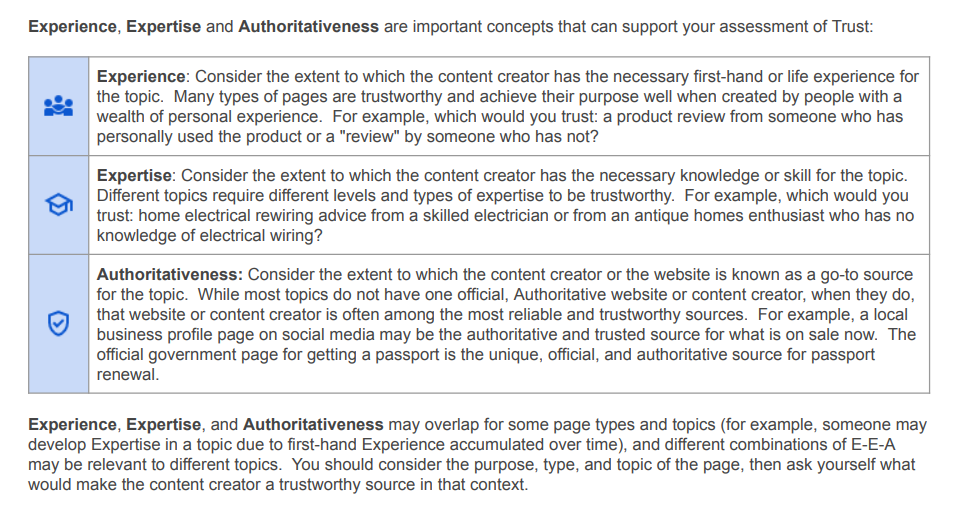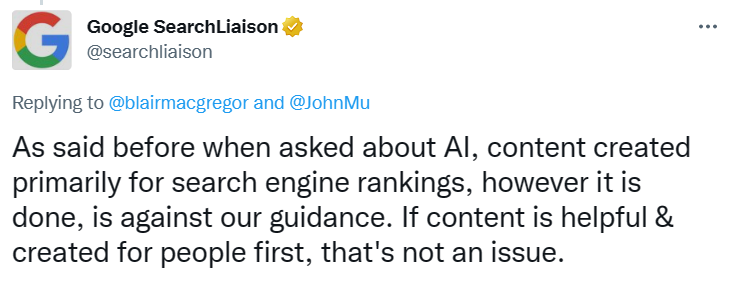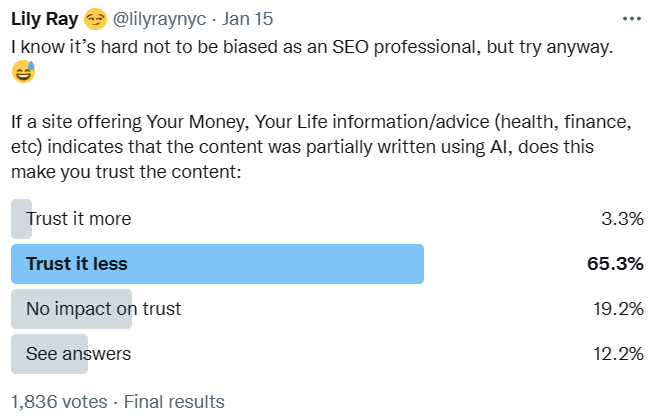If you’ve just gotten used to Google’s E-A-T guidelines, you’re in for a shock. Google has thrown us a curveball and added a new “E” — for Experience.
But what exactly does the new “E” in E-E-A-T mean for SEO going forward, and is this something we should have seen coming for a while?
Let’s take a look at the new update to Google’s Quality Rater Guidelines and how you can ensure you’re doing everything possible to show “Experience” in your website content.
Moving from E-A-T to E-E-A-T
What is the new E in EEAT?
Google updated its Quality Rater Guidelines late last year, changing its well-known content quality acronym from E-A-T to E-E-A-T.
E-A-T used to stand for Expertise, Authoritativeness, and Trustworthiness, before Google added the new “E,” which stands for experience. Meaning E-A-T is now E-E-A-T: Experience, Expertise, Authority, and Trustworthiness.
The emphasis is on content quality, as you might expect. Content quality seems to be top of mind for Google lately, which might not be surprising given the recent concern about low-quality, AI-generated content potentially flooding the web following the release of tools like ChatGPT.
Based on the updated guidelines, the following factors are key in helping Google’s search quality raters determine the quality of website content :
- The page should serve a useful purpose
- Experience, Expertise, Authority, and Trust (E-E-A-T)
- Content quality and quantity
- A description of the website or the creator of the main content
- The reputation of the website or the content creator of the main article
It is important to note that search rankings are not directly affected by the guidelines, which are intended for Google’s human reviewers rather than bots. However, they give you a better idea of what Google prioritizes when it comes to evaluating quality website content.

So, what does this mean exactly for your SEO strategy?
As someone who has worked with niche sites for years, I anticipated the move towards an emphasis on experience since the Google product reviews update back in 2021.
After all, which would you trust more: a product review from someone who has used the product or a review from someone who hasn’t?
Content created by writers with real-world experience in a specific area is generally better equipped to demonstrate expertise. It may also be helpful to show first-hand experience through images and videos.
According to Google’s updated guidelines (see: Section 3.4 page 27), trust is crucial to a successful strategy. Experience, expertise, and authoritativeness can be demonstrated in a search result. But if it is not trustworthy, the content is not considered valuable.
Google’s third-party Search Quality Raters (SQRs) use Google’s search rater guidelines. Rather than influencing ranking by virtue of being built into algorithmic rules, these guidelines help real human reviewers evaluate websites for their quality and relevance to users’ searches and report that information back to Google, which then uses this feedback to improve their search systems.
Adhering to E-E-A-T best practices helps content creators and website managers keep up with Google’s high standards and ensure their content will be poised to withstand all the monthly algorithm changes rolled out by the search engine. This approach, in turn, helps Google ensure the results returned to their users in search are as accurate and reliable as possible.
Why is it important to demonstrate experience in SEO content?
Infusing content with first-hand experience adds another level of quality to Google’s search results. Google evaluates experience based on the content author’s “first-hand or life experience for the topic.” (see Section 3.4 page 26 of the latest QRG.) For example, if you are a proven user of a product or hold qualifications and or awards proving you have the experience to speak on a topic.
Among the best ways to show expertise on your website are:
Use a qualified content team: Write content on your website with the help of subject matter experts (SMEs) and ensure it’s reviewed by qualified professionals and editors. For example, a site about dogs would benefit by having content written by (or, at a minimum, reviewed by) an expert trainer or qualified vet.
Write for humans, not bots: Make sure your content is helpful and valuable to your readers first and foremost, not created solely for the purpose of ranking in the SERPs for a specific keyword.
Showcase your team’s experience: Articles should contain a full author’s bio. Details about each author’s experience, qualifications, professional affiliations, and awards should be provided on SEO-friendly author profiles and about pages.
Don’t miss citations: Sources for the information you provide should be clear and linked to throughout your content.
Using the E-E-A-T guidelines for your content can help Google recognize your website as a trustworthy, authoritative source for content related to your core topics. But beyond that, your website will also appear as a more reliable, respected source to users.
E-E-A-T, ChatGPT, & Auto-Generated Content
ChatGPT has taken the world by storm in recent months. If you (somehow!) haven’t yet heard of the tool, ChatGPT is a natural language processing tool powered by AI. Using the chatbot interface, you can have human-like conversations and much more. With the language model, you can compose emails, write essays, code, and answer questions.
There is a difference between ChatGPT and Google, despite many predicting it will become a search engine competitor.
ChatGPT is a language model designed to facilitate conversations with end users by generating human-sounding responses.
The purpose of a search engine like Google is to index web pages on the internet to make it easier for users to find the information they need — ideally from trustworthy sources.
ChatGPT does not provide comprehensive results in the same way that Google does. A chatbot-generated response relies on the information gleaned from the language model’s training data — which may well be incorrect information, leading to error-prone AI-generated text. Its primary purpose is to create text that reads in a natural-sounding way — not to provide accurate answers to questions.
As stated in Section 4.6.3, Auto-generated MC (Main Content): “Creating an abundance of content with little effort or originality with no editing or manual curation is often the defining attribute of spammy websites. One way to do this is to use ‘auto-generated’ content.”
Furthermore, Google’s updated Spam Policy acknowledges that automatically-generated content is often created primarily to manipulate search rankings, not to provide users with helpful content.
This doesn’t mean that tools like ChatGPT can’t be helpful in content creation — it can be a great tool for brainstorming topics, writing rough outlines, and giving you some general ideas for titles or metadata. But copy/pasting auto-generated text outputs directly from ChatGPT and publishing it on your site as-is cannot be recommended — you’ll still want to edit this content and fact-check it very carefully.
Per Google’s QRG (page 39):
“Pages and websites made up of auto-generated content with no editing or manual curation, and no original content or value added for users, should be rated lowest.”
However, Google stated recently on Twitter that their concern is content quality, not how it’s written. But because AI-generated content is often low quality and prone to including false statements, it still requires human curation. When it comes to adhering to E-E-A-T best practices, AI tools are just that — tools, not editors or subject matter experts. Because E-E-A-T emphasizes trustworthiness, it’s worth noting again that, at this stage, tools like ChatGPT are often not even credible sources of information.

What does this mean? Well, Google’s content guidelines can still be followed if you’re using AI tools, as long as a human edits it, checks its accuracy to ensure the content is accurate and helpful, and, ideally, adds their own spin to it.
Editing auto-generated content in the same way you would with a writer who is not a subject matter expert — by fact-checking and adding your own personal experience and use cases, as well as personality and anecdotes — can help ensure the content is helpful for human readers.
AI content generation tools could be used successfully as part of a content creator’s stack, alongside tools for checking SPAG (spelling/punctuation/grammar), plagiarism, and readability. These tools can help save time with initial research and creating a skeleton base for the content.
This could be useful for new businesses or solopreneurs who do not have the budget for a full content team but have the experience and qualifications to edit the autogenerated content to ensure it meets E-E-A-T guidelines.
However, YMYL (“your money or your life”) content is likely to be scrutinized even closer when it comes to using auto-generated content. Websites that fall into this ‘YMYL’ category should ensure their content is based on information from real experts and very closely fact-checked. Experts’ recommendations, such as those of professional societies, strongly support a positive reputation for E-E-A-T-compliant content.
In fact, a recent Twitter poll by Lily Ray, Senior Director of SEO and Head of Organic Research at Amsive Digital, showed that over 65% of people polled would have less trust in content that was generated by AI for YMYL sites.

What does the E-E-A-T update mean for SEO?
E-E-A-T (or ‘Double E-A-T’) should be considered when writing new content or updating existing content on your website. Google evaluates relevance at the level of the individual document, i.e., each piece of content in relation to the search query and the searcher’s intent.
It is important that your site’s users trust the expertise of the writers and that the content is original, quality-driven, and backed up by first-hand experience.
As SEOs, we are responsible for creating helpful and authentic content. It is crucial to the success of our content that we consult with our clients and SMEs about the topics we are writing about. No doubt, having suggestions or comments from experts with first-hand experience will help us provide customers with the best possible experience, which will, in turn, empower the sites we work on to rank better, help future-proof our sites’ search visibility, and establish a reputation for credible, high-quality content in the view of readers and search engines alike.
What other changes have been made to Google’s Quality Rater Guidelines?
Google’s updated Quality Rater Guidelines also included an appendix page (Appendix 2 in the QRG, for those following along!) to highlight changes throughout the document. The following changes were noted:
Section 1: Page Quality Guideline
The concept and rating criteria have been updated to be more explicit and applicable to various types of websites and content creation models.
Section 2.5 – Understanding the website
Even if the owner and operator of the website are not explicitly stated, it is crucial to know who owns and operates it.
Section 2.5.2
A clear guide on ‘Finding Who is Responsible for the Website and Who
Created the Content on the Page ‘ for each type of webpage. According to Google, it should be clear who owns a website.
Section 3: Overall Page Quality Rating changes
A summary table with top ‘Page Quality Considerations‘ included in PQ ratings has been added by Google (from lowest to highest).
Page quality is now assessed in three steps:
- Analyzing the page’s true purpose and how misleading/harmful it is
- Checking if the page is safe, trustworthy, or spammy
- When a rater determines a page is harmful, untrustworthy, or spammy, they should give it low quality.
- If the page is not harmful, the quality rating is based on how well it achieves its purpose.
Guidelines for Page Quality Rating have been refined/expanded to include the following criteria:
- Section 3.2: Main Content Quality
- Section 3.3.4: Reputation for Websites and Content Creators
- Section 3.4: Experience, Expertise, Authoritativeness, and Trust (E-E-A-T)
- Section 3.4.1: YMYL Topics: Experience or Expertise
Google introduced a new table to distinguish between content requiring experience or expertise. The table shows whether you need everyday experience or real expertise for various topics.
Section 4.2: Harmful to Self or Other Individuals
Topics that meet the YMYL criteria are selected based on their risk of harming users. Google explains what is considered harmful in a detailed table.
In its definition of harmful content, Google appears to differentiate between free speech and violent or harassing speech. The search engine provides several examples of “harmfully misleading information,” including popular internet conspiracy theories that are either inaccurate or contradict well-established scientific beliefs.
Section 5.1: Lacking E-E-A-T
This section provides examples of what it looks like when a page lacks the appropriate level of E-E-A-T.
Final thoughts on the E-E-A-T update
The main goal of the updated E-E-A-T principle is to ensure website and content quality. If you want your website to rank high in the search engine results pages (and be viewed by users as trustworthy and credible), it’s worth paying attention to Google’s E-E-A-T guidelines — especially if your site falls within the “YMYL” category. Your chances of success on the SERPs will increase if you create high-quality content and consult with qualified experts to answer your topics.
To stay ahead of the competition, stay on top of the latest changes and updates to E-E-A-T guidelines. Additionally, it would be best to understand how Google Quality Raters evaluate websites overall, as this gives us some indication of what Google is prioritizing in terms of the type of content it wants to rank high in its search engine results.





